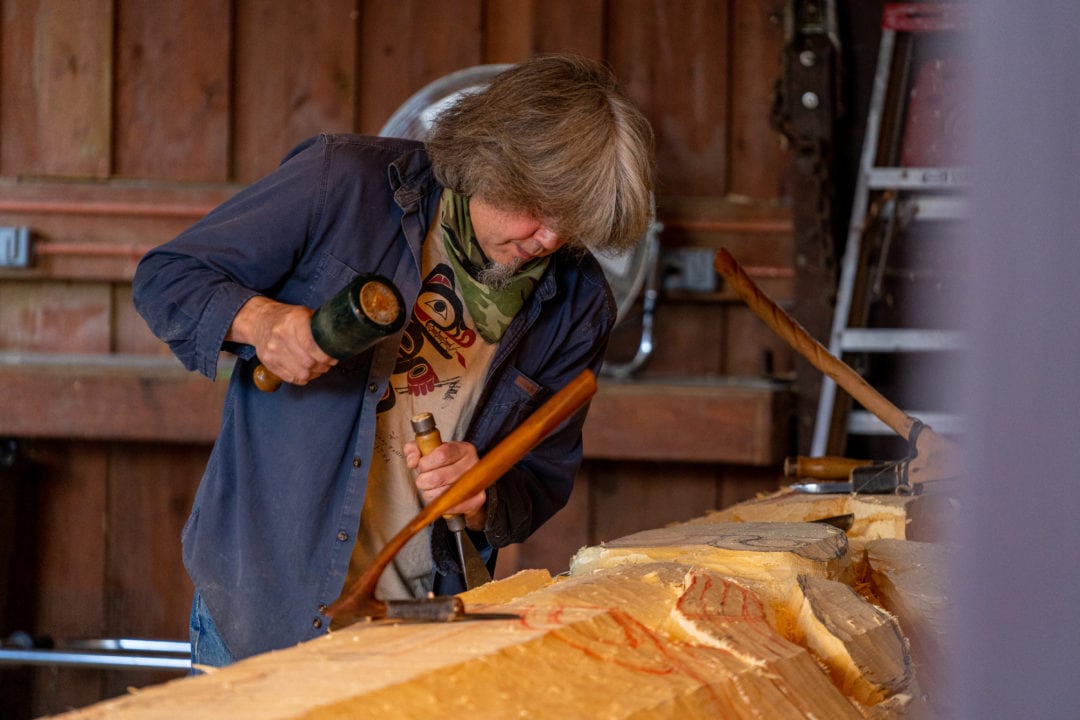Tommy Joseph spends his days with ravens, whales, owls, salmon, and sea monsters. As a longtime totem pole carver in Sitka, Alaska, those creatures, and others symbolic in Alaska Native storytelling, have made frequent appearances in his work. The typical creatures on the totem poles serve myriad purposes: They share stores, record histories, and showcase cultural identity.
“They are part of how we have traditionally shared information,” Joseph, who is Tlingit, explained from his open air studio in Sitka National Historical Park recently.
On that day, Joseph was working on the second reproduction of what’s known as the Waas’go Legend Pole. According to park records, the original totem pole came to Sitka more than 100 years ago from a Haida village elsewhere in Southeast Alaska. In the 1930s, it was remade for the first time and replaced, but that totem eventually fell over and was damaged. The park called upon Joseph, who has done other totems within the park, to handle the new reproduction.

This particular totem pole tells the story of Waas’go, a sea monster in Haida folklore. When told in full, the story is between 4 and 6 hours long, but simply put: It’s a tale of a man and the lengths he goes to in order to impress a disapproving mother-in-law.
Even though it’s a reproduction, Joseph’s totem and the original are far from identical. There’s always room for a bit of creative flair. Though the characters on the yellow cedar log appear in the same order, the depth and details Joseph puts into his totem are different. And like some other artists, it’s easy to identify his work. Granted, he’s carved so many totems in Sitka over his 30-year career that if you were to point to one at random and guess it was Joseph’s, you’d probably be right.
Teaching is half the fun
Joseph first started doing wood carvings in 1972, as an elementary school student. “I’d swipe serrated steak knives out of my mother’s kitchen to practice,” he says. “She didn’t like that.” He’s not sure exactly how many totems he’s done over the years. At one point, he had a ledger that listed the number and the height, but he stopped counting around 500. However, that was a long time ago. Now his creations span not just Alaska, but the U.S. and the world. His favorite, Joseph says, is usually the one he’s currently working on, though others stand out as contenders.
There’s one 20-foot totem at the Petersburg Library, called the Storyteller Pole, which depicts Alaskafied characters from nursery rhythms and children’s books: Mother Goose reimagined as a Canadian Goose with a cedar bark hat, the spirits of Winnie the Pooh and Charlie Brown found in a black bear wearing a chevron shirt, Peter Rabbit amended as a snowshoe hare carrying a staff, and the Cat in the Hat rehashed as an Alaska lynx with a flamboyant chapeau, among others.

Then there’s the 16-foot piece that can be found on the Grand Staircase in the Carnegie Museum of Natural History in Pittsburgh. It depicts a story that a friend of Joseph’s late father told him about a hunting expedition the two had been on. For the last 3 weeks of that project, the museum became his studio. Throughout the final days of the process, he worked before a crowd and was able to answer questions about his heritage.
What is a totem pole?
Although it was a simple totem, Joseph says he particularly enjoys the 9-foot pole that he was asked to make for three questions on an episode of Jeopardy! Originally, only the totem and his handmade, traditional tools were supposed to be included, but when the episode aired, some of his words appeared on screen, too.
Joseph explained that during the filming, the on-air talent was reading one of the clues, when his ears perked up. “She said, ‘Tlingit Indians use this type of wood because it’s soft and easy to carve,’” Joseph says. “I told her, ‘That’s not at all the reason we use it. We use it because it grows really big and is more durable in our climate.’”
The crew ended up rewriting the card and did a few more takes with the correct information. When the question was asked on the show, they instead had Alex Trebek read it—exactly as Joseph had dictated it. For Joseph, teaching others, be it through chatting with them about his work or knowing that they’ll seek out the answers to their questions after viewing his totems, is half the fun.
Joseph worked on the Waas’go Legend Pole for more than 10 months and finished it in early June, ready to be raised in the spot where the original once stood. What project he’ll do next, he’s not sure. But, if his previous work is any indication, it’ll likely be his new favorite.








